most guys can,t weld thin sheet steel thats been galvanized, like old muscle car gas tanks, and IF they do they find they have pin hole leaks, this is rather common and its one reason I normally advise either buying and installing a NEW fuel cell or having a professional welder ,add a sump to your CURRENT OLD , fuel tank, obviously you must have a totally dry and clean fuel tank, thats been pressure cleaned and had a solvent flush then re-pressure cleaned and even then you use a constantly flowing , source of barrier gas like nitrogen to constantly fill and flush the tank while any welds are done to prevent potential problems
I got this info worth reading off the internet
I hope I am not out of line by bringing up a subject that was being discussed in general rodding tech about welding on gas tanks but this one hits a nerve with me because I had a friend die a terrible death and every time someone mentions welding on a gas tank those visions of that terrible day come back. Seems this fellow was using the common and VERY misguided trick of purging a tank with exhaust gas from a gasoline engine to make it "safe" to weld on! This was a diesel fuel tank that in all probability would not have exploded if he had not purged it at all but he did and the exhaust fumes exploded and killed him, he lived for several hours but eventually died from the burns. Being in the welding and mine machinery repair business for many years I personally know of three accidents that have occurred from doing this including the one that killed my friend, the other two guys were luckier and only received injuries although one of these was quite serious. The IMSHA investigator that investigated the fatal accident I mentioned at the mine said that he had seen several accidents caused by purging with exhaust gas including another fatality and that it happens more often than you might think, more so in the auto repair business than at a mine. This all too common myth still persists because some people think that exhaust gas is "dead air" (whatever that means ) and is an inert gas but nothing could be farther from the truth and exhaust gas is quite explosive when mixed with the right amount of Oxygen from the air. I have attempted to argue this point with several welders, one of which was later injured doing it, but usually with little success and it simply amazes me how common this dangerous and just plain stupid myth is. DON'T DO THIS! It can and does kill people!
BTW A GOOD DEAL OF DRY ICE AT LEAST A FEW POUNDS , CAN BE BROKEN UP AND DROPPED INTO A TANK, as a SOURCE OF Co2 SHIELD GAS CRUSHED AND dropped into a carefully cleaned gas tank CAN SUPPLY THE NITROGEN IF YOU DON,T HAVE A WELDING TANK FULL TO USE AS A CONSTANT FLUSH, just REMEMBER CO2 IS HEAVY IT WILL FILL THE TANK IF THE OPENING IS AT THE TOP OR DRAIN OUT LIKE WATER IF THE OPENINGS LOWER THAT THE TOP POINT, the REALLY GOOD POINT IS IT EVAPORATES AND LEAVES NO RESIDUAL TRACE
the stock fuel system works fine on a nearly stock engine, it generally won,t keep up with the needs of an engine with double or triple the original power levels
http://www.centuryperformance.com/fuel.asp
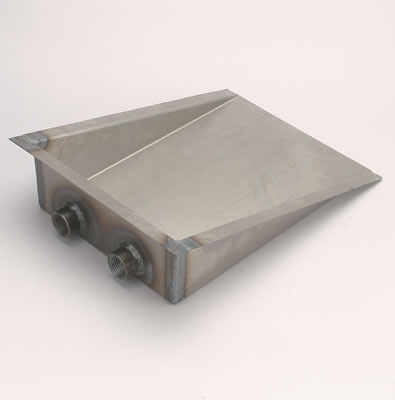
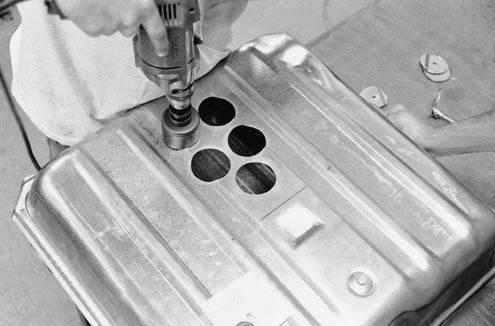
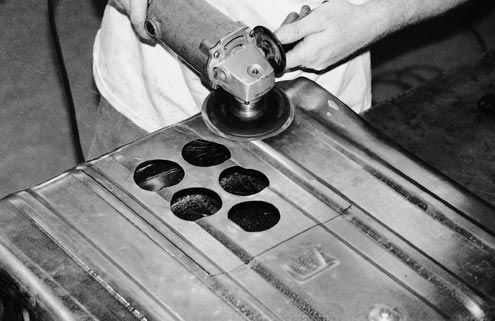
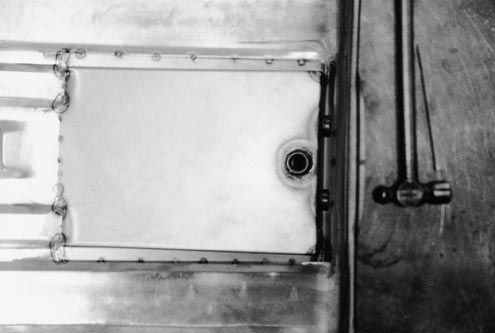
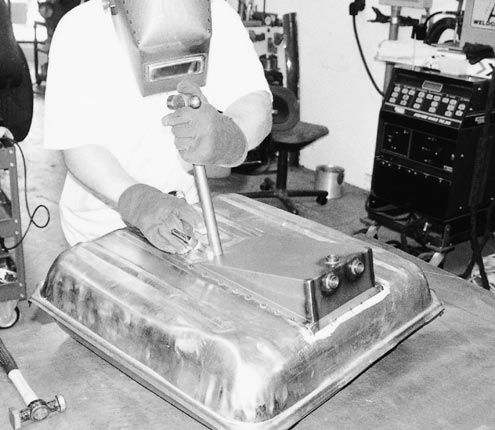
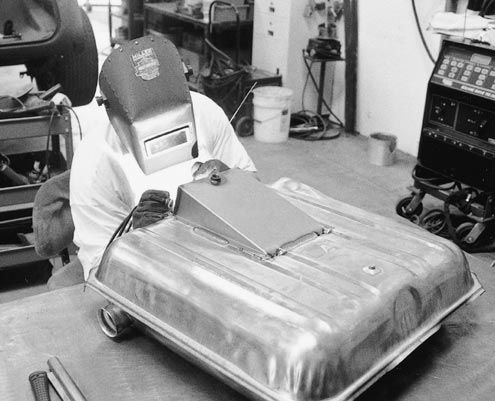
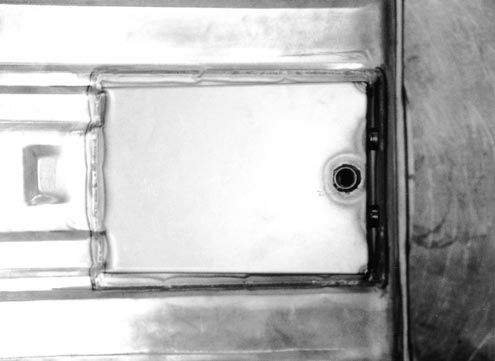
lots of guys find BRAZING on thin fuel tanks far easier than WELDING so thats an option at times, but any time you get significant heat or flame near a fuel tank taking SAFETY precautions are MANDATORY
btw theres a tendency for new guys to cut a large square hole in the tank floor when welding this type of sump to the original tank floor, thats a very BAD idea, it lowers the structural strength, the correct way is to drill about 4-5 3/4" holes in the floor of the old tank slightly nearer the shallow end of the sump from the center line of the sump in the old tank floor,so fuel falls in and is trapped under high G forces during acceleration and braking, this also tends to limit the tank floor from warping due to heat during the weld process, (you should tack weld about 8 spaced welds then fill/weld each area between the tack welds skipping diagonally as you go to limit heat/warp
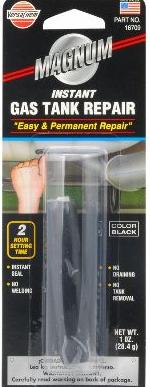
heres a two part epoxy thats used to seal minor leaks ,its cheap easy and works reasonably well on dumb stuff like if you managed to drill a hole or screw a screw into a basically solid gas tank cost about $6
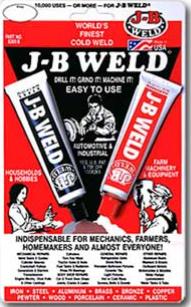
heres another well known two part epoxy thats used to seal minor leaks ,its cheap easy and works reasonably well on dumb stuff like if you managed to drill a hole or screw a screw into a basically solid gas tank, Ive seen this used with a patch made from aluminum window screen to path a gas tank hole that was as large as a quarter and its still working and not leaking decades later even though I frequently advise the owner of a certain 1955 chevy pick-up that he should replace the tank cost about $6
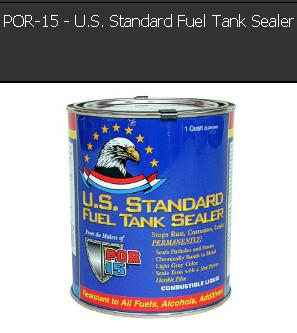
here is a gallon can of a interior surface gas tank coat that you put in a clean & dry gas tank that may have some minor pin hole leaks, it comes with instructions, you basically add some to the tank and constantly and randomly turn the tank until the interiors well coated then set the tank in its normal position and let the coating solidify, its a bit like a high quality fiberglass resin thats totally fuel resistant that forms a solid permanent film barrier to prevent more rust or pin hole leaks.. cost about $110
READ THESE RELATED THREADS/LINKS, THAT CONTAIN A GOOD DEAL MORE RELATED INFO
http://www.hotrod.com/howto/70438_gas_tank_weld/
http://www.aluminumrepair.com/fuel-tank-repair.htm
viewtopic.php?f=32&t=33
viewtopic.php?f=55&t=211&p=247&hilit=+sump+tank#p247
viewtopic.php?f=55&t=4381
viewtopic.php?f=55&t=635
viewtopic.php?f=55&t=1939&p=5137&hilit=fuel+filters#p5137
viewtopic.php?f=55&t=733&p=6470&hilit=fuel+cell#p6470
viewtopic.php?f=55&t=6105&p=18854&hilit=fuel+filters#p18854
I got this info worth reading off the internet
I hope I am not out of line by bringing up a subject that was being discussed in general rodding tech about welding on gas tanks but this one hits a nerve with me because I had a friend die a terrible death and every time someone mentions welding on a gas tank those visions of that terrible day come back. Seems this fellow was using the common and VERY misguided trick of purging a tank with exhaust gas from a gasoline engine to make it "safe" to weld on! This was a diesel fuel tank that in all probability would not have exploded if he had not purged it at all but he did and the exhaust fumes exploded and killed him, he lived for several hours but eventually died from the burns. Being in the welding and mine machinery repair business for many years I personally know of three accidents that have occurred from doing this including the one that killed my friend, the other two guys were luckier and only received injuries although one of these was quite serious. The IMSHA investigator that investigated the fatal accident I mentioned at the mine said that he had seen several accidents caused by purging with exhaust gas including another fatality and that it happens more often than you might think, more so in the auto repair business than at a mine. This all too common myth still persists because some people think that exhaust gas is "dead air" (whatever that means ) and is an inert gas but nothing could be farther from the truth and exhaust gas is quite explosive when mixed with the right amount of Oxygen from the air. I have attempted to argue this point with several welders, one of which was later injured doing it, but usually with little success and it simply amazes me how common this dangerous and just plain stupid myth is. DON'T DO THIS! It can and does kill people!
BTW A GOOD DEAL OF DRY ICE AT LEAST A FEW POUNDS , CAN BE BROKEN UP AND DROPPED INTO A TANK, as a SOURCE OF Co2 SHIELD GAS CRUSHED AND dropped into a carefully cleaned gas tank CAN SUPPLY THE NITROGEN IF YOU DON,T HAVE A WELDING TANK FULL TO USE AS A CONSTANT FLUSH, just REMEMBER CO2 IS HEAVY IT WILL FILL THE TANK IF THE OPENING IS AT THE TOP OR DRAIN OUT LIKE WATER IF THE OPENINGS LOWER THAT THE TOP POINT, the REALLY GOOD POINT IS IT EVAPORATES AND LEAVES NO RESIDUAL TRACE
the stock fuel system works fine on a nearly stock engine, it generally won,t keep up with the needs of an engine with double or triple the original power levels
http://www.centuryperformance.com/fuel.asp







lots of guys find BRAZING on thin fuel tanks far easier than WELDING so thats an option at times, but any time you get significant heat or flame near a fuel tank taking SAFETY precautions are MANDATORY
btw theres a tendency for new guys to cut a large square hole in the tank floor when welding this type of sump to the original tank floor, thats a very BAD idea, it lowers the structural strength, the correct way is to drill about 4-5 3/4" holes in the floor of the old tank slightly nearer the shallow end of the sump from the center line of the sump in the old tank floor,so fuel falls in and is trapped under high G forces during acceleration and braking, this also tends to limit the tank floor from warping due to heat during the weld process, (you should tack weld about 8 spaced welds then fill/weld each area between the tack welds skipping diagonally as you go to limit heat/warp

heres a two part epoxy thats used to seal minor leaks ,its cheap easy and works reasonably well on dumb stuff like if you managed to drill a hole or screw a screw into a basically solid gas tank cost about $6

heres another well known two part epoxy thats used to seal minor leaks ,its cheap easy and works reasonably well on dumb stuff like if you managed to drill a hole or screw a screw into a basically solid gas tank, Ive seen this used with a patch made from aluminum window screen to path a gas tank hole that was as large as a quarter and its still working and not leaking decades later even though I frequently advise the owner of a certain 1955 chevy pick-up that he should replace the tank cost about $6

here is a gallon can of a interior surface gas tank coat that you put in a clean & dry gas tank that may have some minor pin hole leaks, it comes with instructions, you basically add some to the tank and constantly and randomly turn the tank until the interiors well coated then set the tank in its normal position and let the coating solidify, its a bit like a high quality fiberglass resin thats totally fuel resistant that forms a solid permanent film barrier to prevent more rust or pin hole leaks.. cost about $110
READ THESE RELATED THREADS/LINKS, THAT CONTAIN A GOOD DEAL MORE RELATED INFO
http://www.hotrod.com/howto/70438_gas_tank_weld/
http://www.aluminumrepair.com/fuel-tank-repair.htm
viewtopic.php?f=32&t=33
viewtopic.php?f=55&t=211&p=247&hilit=+sump+tank#p247
viewtopic.php?f=55&t=4381
viewtopic.php?f=55&t=635
viewtopic.php?f=55&t=1939&p=5137&hilit=fuel+filters#p5137
viewtopic.php?f=55&t=733&p=6470&hilit=fuel+cell#p6470
viewtopic.php?f=55&t=6105&p=18854&hilit=fuel+filters#p18854
Last edited by a moderator:
